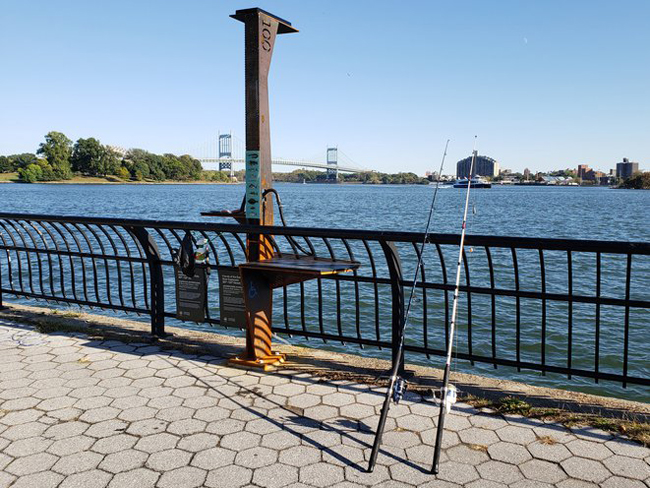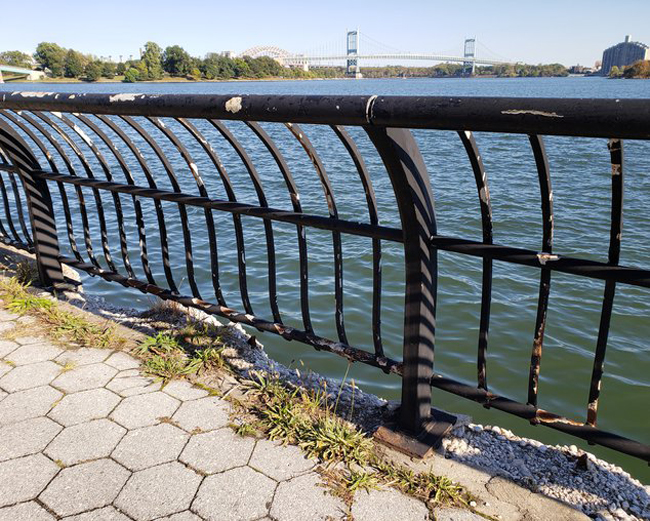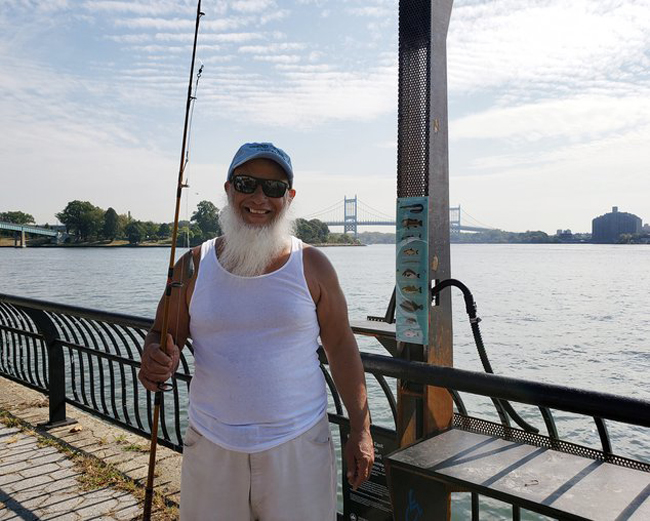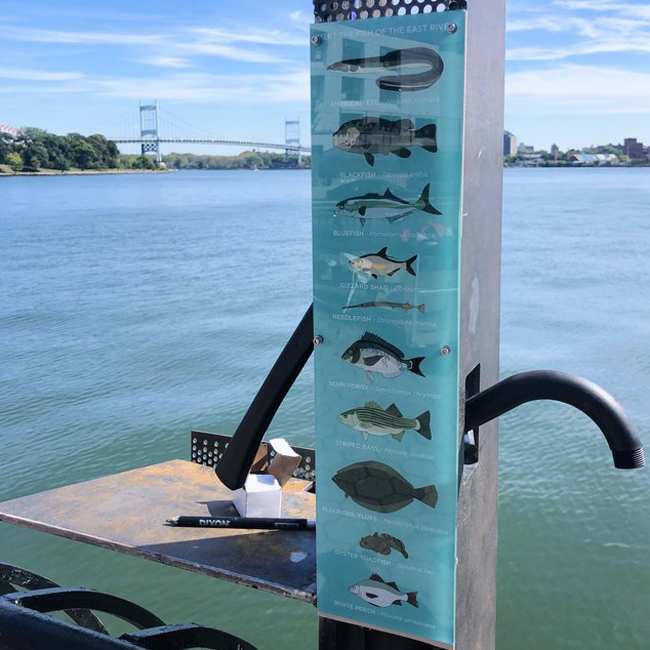
El Barrio Bait Station designed by JACOBSCHANG Architecture. Credit: Clarisa Diaz, Gothamist
NOTE: El Barrio Bait Station is located on 100th Street of the East River Esplanade. It was constructed pro bono by SMI Construction Management, Inc., Maspeth Welding, and Robert Silman Associates.
Hear reporter Clarisa Diaz talk about El Barrio Bait Station on WNYC's All Things Considered:
If you don't see the player above, it's because you're using a
non-Flash device (eg, iPhone or iPad). You can download the mp3 file by clicking here (mp3). It may take a few minutes to download, so please be patient.
— By Clarisa Diaz, Gothamist, WNYC FM
East Harlem, NY, October 9, 2019 - Mayra Ayala and Eddie McCoy fish together every weekend on the East River Esplanade. “I’ve caught eels, striped bass, the oyster toadfish, the bluefish, the blackfish, and it was my first time this year catching the flounder,” said Ayala as she pointed out fish illustrated on the newly installed El Barrio Bait Station.
The idea to build for a fishing-centric resource was first suggested by local anglers to Friends of the East River Esplanade. “Our El Barrio East Harlem fishing committee came to us and said, ‘What you could do is make us a bait station,’” said Jennifer Ratner, board chair of Friends of the East River Esplanade 60th-120th St.
It just so happened that one of the group's board members, Sari Chang, is an architect, who noticed anglers challenged by the esplanade’s lack of infrastructure. “When you come out here in the spring and fall, you see a lot of people out here. And I think there's a need. They’re often just on the ground, on the concrete here cutting fish or even on these benches," she said.
The Friends of the East River Esplanade applied for funding from New York Sea Grant and the New York State Department of Environmental Conservation, and, by this spring, the group was awarded $15,000 for the new bait station.
Chang, principal of JACOBSCHANG Architecture, designed an ADA-accessible station, which includes a solar panel to create lighting, can pump non-potable water, and features weathered steel surfaces for cutting bait and measuring fish.

One of many spots in El Barrio where the esplanade is crumbling. Credit: Clarisa Diaz, Gothamist
“This stretch of esplanade unlike many waterfronts around the city has gotten worse,” explained Ratner, referring to the crumbling walkways. “We're thrilled. It seems like a small project but it's really exciting. We hope that it's a prototype for waterfronts around the city and we hope that our waterfront gets taken care of—that this is just a small symbol to say that there are people here who want this waterfront better.”
According to Ratner, many anglers are aware of fish advisories from the New York State Department of Health. “There are definitely health concerns, certainly pregnant women and children should never eat this fish. A lot of them get thrown back actually. The ones [anglers] that we know and certainly the ones that come to our committee are very, very cognizant of the health rules,” Ratner said. The catching and releasing of fish is also a favorite pastime for McCoy and Ayala. “We only do this for fun. We don’t eat the fish, we throw them back,” said McCoy.

Rafael Portela, fishes daily in the area catching 28” or longer striped bass and bluefish. Credit: Clarisa Diaz, Gothamist
“This is the result of just a few months of a project which is great because you don't always see results that quickly,” said Paul Focazio, communications manager at NY Sea Grant. The project is a model of a federal-state program partnering with a local group to create small but immediate improvement.
"There are 33 Sea Grant programs in the country. They’re all funded through NOAA and in New York, we’re funded through Cornell and the SUNY system," he explained, adding, "For us it's really great to work with folks like Friends of Esplanade because they know the communities so well and they can really tell us what they need."
"It would be great if we could get multiple bait stations out here, not just one," Chang said.
Disclosure: I found out about this project because Chang actually reached out to me in May, asking if my illustrations could be used on the bait station. I said yes and saw the completed station at last week's ribbon-cutting.

Here's the sign showing fish, illustrated by Gothamist/WNYC's Clarisa Diaz, at the bait station. Credit: Sari Chang, JACOBSCHANG Architecture
More Info: Marine Small Grants
This project was supported by a partnership between New York Sea Grant, the New York State Department of Environmental Conservation, and the Marine and Coastal District of New York Conservation, Education, and Research Grants Program.
Funding is supported from the Marine and Coastal District License Plate which is administered by the Marine and Coastal District of New York Conservation, Education and Research Board, and authorized through NYS Environmental Conservation Law Article 13, Title 5 Section 13-0503. Any opinions, findings, and conclusions or recommendations expressed in this publication are those of the authors(s) and do not necessarily reflect the views of New York State Department of Environmental Conservation, Stony Brook University or New York Sea Grant.
More Info: New York Sea Grant
New York Sea Grant (NYSG), a cooperative program of Cornell University
and the State University of New York (SUNY), is one of 34 university-based
programs under the National Oceanic and Atmospheric Administration’s
National Sea Grant College Program.
Since 1971, NYSG has represented a statewide network of integrated
research, education and extension services promoting coastal community
economic vitality, environmental sustainability and citizen awareness
and understanding about the State’s marine and Great Lakes resources.
Through NYSG’s efforts, the combined talents of university scientists
and extension specialists help develop and transfer science-based
information to many coastal user groups—businesses and industries,
federal, state and local government decision-makers and agency managers,
educators, the media and the interested public.
The program maintains Great Lakes offices at Cornell University, SUNY
Buffalo, SUNY Oswego and the Wayne County Cooperative Extension office
in Newark. In the State's marine waters, NYSG has offices at Stony Brook
University in Long Island, Brooklyn College and Cornell Cooperative
Extension in NYC and Kingston in the Hudson Valley.
For updates on Sea Grant activities: www.nyseagrant.org has RSS, Facebook, Twitter, and YouTube links. NYSG offers a free e-list sign up via www.nyseagrant.org/nycoastlines for its flagship publication, NY Coastlines/Currents, which is published quarterly. Our program also produces an occasional e-newsletter,"NOAA Sea Grant's Social Media Review," via its blog, www.nyseagrant.org/blog.